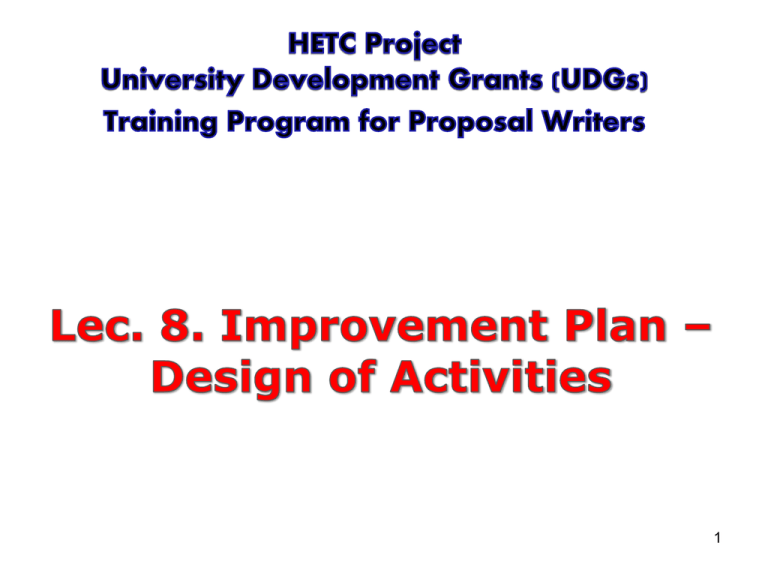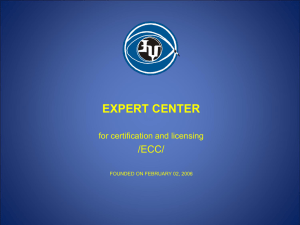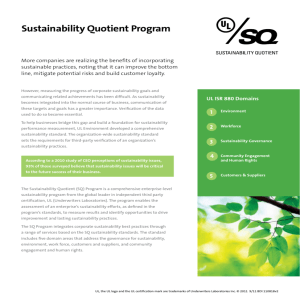Lec 8. Improvement Plan - Design of Activities by APA
advertisement

1 OPERATIONAL PLANNING External Environment HETC PROJECT (Local, National, Global) Trend Ideology; Politics; Culture; Science; Education System Mission Vision Goals Stakeholders Students; Staff; Users; Government Data Collection PROPOSAL University of …………….. Job Market Industry; Community; Government; Others Data Analysis Organizational Resources Process & Output & Human; Physical; Services Outcome Culture Financial Problem Identification Improvement Plan - Designing Activities We are here now Internal Environment 2 Conceptualizing the Improvement Plan Having identified the problems, root causes of problems, and possible solutions, the taskforce should select the most suitable set of solutions from all possible solutions Convert the selected set of solutions into activities and sub-activities, including estimates of resources required 3 IMPROVEMENT PLAN PRESENT CONDITION DESIRED CONDITION IMPROVEMENT PLAN Comprehensiveness Coherence Clarity Soundness 4 IDENTIFIED PROBLEMS ACTIVITIES IMPROVEMENT PLAN • SWOT • Force-Field • PEST • Gap etc 5 FORCE-FIELD ANALYSIS PROBLEM Forces – Factors influencing problems Driving Forces change an equilibrium towards favourable conditions Certain conditions in a working organization resulting dissatisfaction Restraining Forces change an equilibrium towards unfavourable conditions 6 CONSTRUCTING ACTIVITIES Activity 1: • Reducing Factor 2 • Reducing Factor 4 • Increasing Factor 2’ Restraining Forces 1 1’ 2 2’ 3 3’ Driving Forces 4 4’ Activity 2: • …………………… • …………………… • …………………… Activity 3: • …………………… • …………………… • …………………… 7 DESIGNING ACTIVITIES Investment based Proposal E.g. Improving laboratory facilities should be transformed to Outcome based Proposal E.g. Improving Skills An investment cannot be claimed as an activity ! 9 DESIGNING ACTIVITIES Rules to observe in designing an Activity Activity is Not just an Investment Activity should have clear Output Activity should have clear Reason/Rationale Why do we need to have this activity Why we select this activity rather than others What is this activity aimed at An investment is just a direct consequence of having an activity (necessary Resources Required to conduct that activity) ! 10 DESIGNING ACTIVITIES Criteria of a Good Activity Simple – not complicated Measurable – achievement/progress can be measured Achievable – the scope is manageable Rewarding – Output/Outcome contribute to the objectives Timeframe – properly planned staging Sustainable – does not stop at the end of the project life Students as the Primary Beneficiary ! 11 ACTIVITY FORMAT (Guidelines – pp.10-11) Name of Activity ……………………………………………………… Background & Rationale Why the activity is needed (link to problems) & How it would solve problems Objective(s) What are the Objectives, Outcomes & Beneficiaries Mechanism & Design Implementation Schedule Resources Required Performance Indicators Sustainability How the activity will be implemented (sub-activities) When the activity will be carried out (time-schedule) What are the resources needed How its effectiveness will be measured How to sustain the activity 12 ACTIVITY – EXAMPLE Name of Activity : Improving English Language Skills of Undergraduate Students 13 Background & Rationale • Graduate employment rate low • Their English language skills do not satisfy present job market • English courses are offered but motivation of students is low • Undergraduates have inadequate levels of English proficiency- less opportunities available at the university for improvement • Undergraduates should be provided more learning opportunities to improve English language Skills 14 Objective(s) Students would be able to • complete the specified English language skills certification programme satisfactorily • follow selected courses in the degree programme in English medium without difficulties • find a good employment within a short period after the graduation 15 Mechanism& Design • English language skills certification programme linked to labor market needs • Motivating students for self-learning (selected Courses in English medium, assignments etc) • Monitoring & Evaluation 16 Implementation Schedule Activity 1. Enhancing ICT Skills 2. Improving English Language Skills SubActivity Year 1 Q1 Q2 Q3 Year 2 Q4 Q1 Q2 Q3 Year 3 Q4 Q1 Q2 Q3 Q4 1.1. …………. 1.2. …………. 1.3. …………. 2.1. …………. 2.2. …………. 2.3. …………. 3. Strengthening Soft Skills 3.1. …………. 4. Promoting Ethnic Cohesion 4.1. …………. 3.2. …………. 4.2. …………. 17 Resources Required • Instructors • Audio-visual & other equipment for language lab • Books, other self learning materials etc. 18 Performance indicators • Outcome Indicator: Proportion of students completing the English language skills certification programme • Intermediate Outcome indicator: No of students enrolled in English language skills certification programme • Auxiliary indicator: …………………. 19 Sustainability • Make the English language skills certification programme compulsory • Financial sustainability: University funds/generated funds 20 UNSUSTAINABLE ACTIVITY SYMPTOMS 1. Waiting Time for the First job – High 2. First Salary – Low 3. Ability to compete with other graduates – Low Proposed Activity Improving English Language Skills POSSIBLE PROBLEMS 1. Poor Management Skills 2. Poor ICT Skills 3. Poor English Language Skills Mechanism & Design Intensive English Course for Final Year Students at the Language Centre INFLUENCING FACTORS 1. 2. 3. 4. 5. 6. 7. 8. Poor Management Skills Students’ English Proficiency – Low Staff English Proficiency – Low Course Units in English Medium – None Library Collection in English – Inadequate Literature Survey assignments – None Language Centre – Available Student Motivation to learn English – Low Resources Required • Short-Term Staff Training • Equipment for Language Centre(s) 21 SUSTAINABLE ACTIVITY SYMPTOMS 1. Waiting Time for the First job – High 2. First Salary – Low 3. Ability to compete with other graduates – Low POSSIBLE PROBLEMS 1. Poor Management Skills 2. Poor ICT Skills 3. Poor English Language Skills Proposed Activity Improving English Language Skills Mechanism & Design •Course Units in English •Literature Surveys •Motivating Students for Self Learning INFLUENCING FACTORS 1. 2. 3. 4. 5. 6. 7. 8. Poor Management Skills Students’ English Proficiency – Low Staff English Proficiency – Low Course Units in English Medium – None Library Collection in English – Inadequate Literature Survey assignments – None Language Centre – Available Student Motivation to learn English – Low Resources Required •Short-Term Staff Training •Equipment for Language Centre(s) •Self Learning Materials 22 TYPICAL FLAWS Background & Rationale No link to the Identified Problems; Failure to justify the Proposed Activity Objective(s) Too Broad; No link to the Background Mechanism & Design Vague; Too General; Confusion about Investments (Cost Components) Implementation Schedule Wrong sequence; Inconsistent with Targets; Confusion about Investments (Cost Components) Sustainability Focus only on the Financial Aspect 23 there are no favorable winds for those who do not know where to go ….! 24











